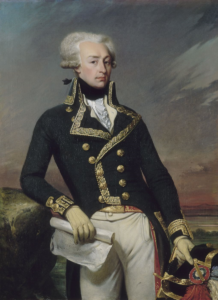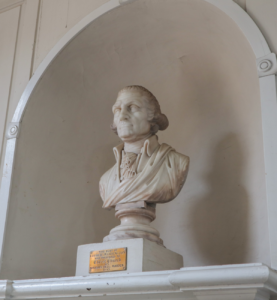Lafayette: America’s Favorite Frenchman
 By Danielle DeVantier, Old North Illuminated Intern
By Danielle DeVantier, Old North Illuminated Intern
Gilbert du Motier, the Marquis de Lafayette, made eight visits to Boston during his travels to the United States. According to Boston’s city records, he made six trips between 1778 and 1784 and two trips between 1824 and 1825.[1] Lafayette served with distinction under General George Washington and acted as his trusted advisor, earning a place of honor in the hearts of Americans during and after the American Revolution. He was celebrated on each of his returns to the city by adoring citizens, especially the enthusiastic receptions in 1824 after being in France for nearly 40 years.[2]
Lafayette shared just as much admiration for Americans and their fight for national independence. On his 1824 visit to Boston, he addressed the city hoping they would, “Accept the respectful and warm thanks of a heart which has for nearly half a century been particularly devoted to your illustrious city.”[3] He made slow progress on this tour, as so many people showed up to give him their thanks and praise. The generation of those who led the American Revolution, who came to be known as the country’s founding fathers, had few living members left. As a veteran of the Revolution and a living reminder of the independence that Americans had fought for, Lafayette’s arrival was a major cause for celebration.
After his American tour brought him to Providence, Rhode Island, Lafayette made his way slowly to Boston. He walked part of the way to personally greet the veterans and companies of militia who had come to see him. Lafayette finally arrived at Governor William Eustis’s home in Roxbury at 1:00am on August 24, 1824.[4] Lafayette was good friends with Eustis from their days as Washington’s advisors and their time in Europe while Eustis was the American ambassador to the Netherlands. Accounts of their reunion recall it to be a happy and affectionate moment.[5]
 Lafayette’s return to the Commonwealth of Massachusetts took him on a tour of the major sites of the Revolution, a memorial of the country’s fight for independence and his part in the Revolution. In early September of 1824, he visited Old North Church. A bust of George Washington has been displayed in the church since 1815.[6] Bishop Coxe, of Buffalo, New York, wrote that Lafayette responded to questions of the bust’s likeness to General Washington, saying, “Yes, that is the man I knew, and more like him than any other portrait, bust or picture.”[7]
Lafayette’s return to the Commonwealth of Massachusetts took him on a tour of the major sites of the Revolution, a memorial of the country’s fight for independence and his part in the Revolution. In early September of 1824, he visited Old North Church. A bust of George Washington has been displayed in the church since 1815.[6] Bishop Coxe, of Buffalo, New York, wrote that Lafayette responded to questions of the bust’s likeness to General Washington, saying, “Yes, that is the man I knew, and more like him than any other portrait, bust or picture.”[7]
Lafayette left Boston for France on September 7, 1825. He took with him soil from Bunker Hill, that would nine years later, cover his casket in Paris, ensuring that America and the Revolution were always with him.[8]
Footnotes
[1] Boston, Massachusetts City Record. United States: Superintendent of Printing, 1917, p. 836, https://www.google.com/books/edition/City_Record/9TZJAQAAMAAJ?q=&gbpv=1#f=true.
[2] Jake Sconyers and Nikki Stewart, “Boston’s Favorite Fighting Frenchman (Episode 163)”, December 15, 2019, 08:15, https://www.hubhistory.com/episodes/bostons-favorite-fighting-frenchman-episode-163/.
[3] S. Andrus, A Complete History of the Marquis de Lafayette, Major-general in the American Army in the War of the Revolution: Embracing an Account of His Tour Through the United States, to the Time of His Departure, September, 1825, United States: 1846, p. 361, https://www.google.com/books/edition/A_Complete_History_of_the_Marquis_de_Laf/VcUEAAAAYAAJ?q=&gbpv=1#f=false
[4] Sconyers, “Boston’s Favorite Fighting Frenchman (Episode 163)”, 19:04.
[5] Sconyers, 12:35.
[6] Wall text, The Bust of Washington, Old North Church, Boston, Massachusetts.
[7] Bishop Arthur Cleveland Coxe of Buffalo, 1891.
[8] Sconyers, 57:40.
Bibliography
Andrus, S. A Complete History of the Marquis de Lafayette, Major-general in the American Army in the War of the Revolution: Embracing an Account of His Tour Through the United States, to the Time of His Departure, September, 1825. United States: 1846. https://www.google.com/books/edition/A_Complete_History_of_the_Marquis_de_Laf/VcUEAAAAYAAJ?q=&gbpv=1#f=false.
Boston, Massachusetts City Record. United States: Superintendent of Printing. 1917. https://www.google.com/books/edition/City_Record/9TZJAQAAMAAJ?q=&gbpv=1#f=true.
Coxe, Arthur Cleveland. 1891 letter.
Sconyers, Jake and Nikki Stewart. “Boston’s Favorite Fighting Frenchman (Episode 163).” December 15, 2019. https://www.hubhistory.com/episodes/bostons-favorite-fighting-frenchman-episode-163/.
Wall text. The Bust of Washington. Old North Church. Boston, Massachusetts.
